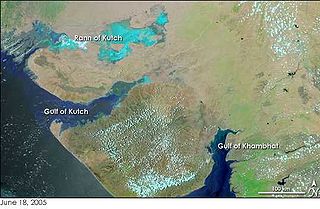
The Great Rann of Kutch is a salt marsh in the Thar Desert in the Kutch District of Gujarat, India. It is about 7500 km2 in area and is reputed to be one of the largest salt deserts in the world. This area has been inhabited by the Kutchi people.

Kutch district is a district of Gujarat state in western India, with its headquarters (capital) at Bhuj. Covering an area of 45,674 km², it is the largest district of India. The area of Kutch District is larger than the entire area of states like Haryana (44,212 km2) and Kerala (38,863 km2) The population of Kutch is about 2,092,371. It has 10 talukas, 939 villages and 6 municipalities. The Kutch district is home to the Kutchi people who speak the Kutchi language.

The Gulf of Kutch is an inlet of the Arabian Sea along the west coast of India, in the state of Gujarat, which is renowned for extreme daily tides.
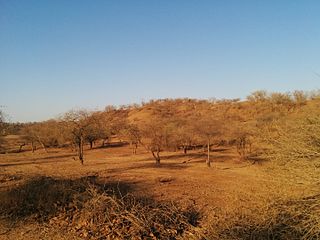
The Khathiar–Gir dry deciduous forests is a mostly arid ecoregion in northwestern India that stretches over 103,100 sq mi (267,000 km2) across Gujarat, Rajasthan and Madhya Pradesh. The dry deciduous forests in the region are dominated by teak, and thorny trees and scrub in drier areas.

The Little Rann of Kutch is a salt marsh which is part of the Rann of Kutch in Kutch district, Gujarat, India.

The great Indian bustard or Indian bustard, is a bustard found on the Indian subcontinent. A large bird with a horizontal body and long bare legs, giving it an ostrich like appearance, this bird is among the heaviest of the flying birds. Once common on the dry plains of the Indian subcontinent, as few as 150 individuals were estimated to survive in 2018 and the species is critically endangered by hunting and loss of its habitat, which consists of large expanses of dry grassland and scrub. These birds are often found associated in the same habitat as blackbuck. It is protected under Wildlife Protection Act 1972 of India.
Rann of Kutch Wildlife Sanctuary is located in Badin District, Sindh, Pakistan.
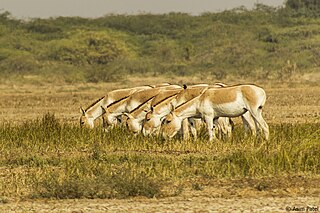
Indian Wild Ass Sanctuary also known as the Wild Ass Wildlife Sanctuary is located in the Little Rann of Kutch in the Gujarat state of India. It is spread over an area of 4954 km².
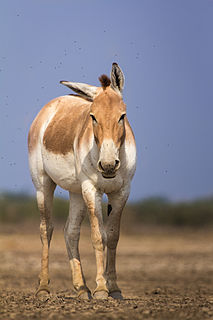
The Indian wild ass, also called the Indian onager or, in the local Gujarati language, Ghudkhur and Khur, is a subspecies of the onager native to Southern Asia.
Banni Grasslands Reserve or Banni grasslands form a belt of arid grassland ecosystem on the outer southern edge of the desert of the marshy salt flats of Rann of Kutch in Kutch District, Gujarat State, India. They are known for rich wildlife and biodiversity and are spread across an area of 3,847 square kilometres. They are currently legally protected under the status as a protected or reserve forest in India. Though declared a protected forest more than half a century ago Gujarat state's forest department has recently proposed a special plan to restore and manage this ecosystem in the most efficient way. Wildlife Institute of India (WII) has identified this grassland reserve as one of the last remaining habitats of the cheetah in India and a possible reintroduction site for the species.
The Chari-Dhand wetland conservation reserve is located on the edge of arid Banni grasslands and the marshy salt flats of the Rann of Kutch in Kutch District, Gujarat State in India. It is currently legally protected under the status as a Protected or Reserve Forest in India. Chari means salt affected and Dhand means shallow wetland, Dhand is a Sindhi word for a shallow saucer shaped depression. This is a seasonal desert wetland and only gets swampy during a good monsoon, receiving water from the north flowing rivers as well as from the huge catchment areas of many surrounding big hills. It is spread over an area of 80 km2. It is in Nakhtrana Taluka, 80 km south west to the city of Bhuj, about 7 or 8 km from Fulary village and 30 km from Nakhtrana town. It is home to nearly two lakh birds with migratory and endangered species of birds flocking into the area in thousands during monsoon and winters.

The Rann of Kutch is a large area of salt marshes that span the border between India and Pakistan. It is located mostly in Gujarat, India, and in some parts of Sindh, Pakistan. It is divided into the Great Rann and Little Rann.
Kutch Desert Wildlife Sanctuary is situated in the Great Rann of Kutch, Kutch district, Gujarat, India, it was declared a sanctuary in February 1986. It is the largest Wildlife Sanctuary in India areawise.

Narayan Sarovar Sanctuary also popularly known as Narayan Sarovar Wildlife Sanctuary or Narayan Sarovar Chinkara Sanctuary notified as such in April 1981 and subsequently denotified in 1995 with reduced area, is a unique eco-system near Narayan Sarovar in the Lakhpat taluka of Kutch district in the state of Gujarat, India. The desert forest in this sanctuary is said to be the only one of its kind in India. Located in the arid zone, a part of it is a seasonal wetland. It has 15 threatened wildlife species and has desert vegetation comprising thorn and scrub forests. Its biodiversity has some rare animals and birds, and rare flowering plants. Wildlife Institute of India (WII) has identified it as one of the last remaining habitats of the cheetah in India and a possible reintroduction site for the species. The most sighted animal here is the chinkara, which is currently the flagship species of the sanctuary.

Kutch Bustard Sanctuary or Kachchh Great Indian Bustard Sanctuary, also known as Lala–Parjan Sanctuary, is located near Jakhau village in Taluka Abdasa, Gujarat, India. This sanctuary is one of the two great Indian bustard sanctuaries in Gujarat; the other one is in Jamnagar. It was declared as a sanctuary in July 1992, specifically for the conservation of the great Indian bustard, the heaviest flying bird belonging to the avian family of Otididae. However, the sanctuary presently legally covers a protected area of about 2 square kilometres (0.77 sq mi) of area (202.86 hectares of fenced land only and is the smallest sanctuary in the country. Several suggestions have been made to vastly increase the size of this sanctuary as it is a breeding ground of the endangered great Indian bustard. The reason is that its ecological zone is much larger on account of anthropogenic and cattle population pressure that are considered as a ‘biotic threat’ to this omnivorous species.
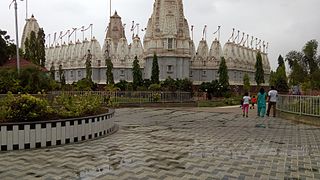
Naliya is a town, which is also the taluka headquarters of Abdasa Taluka of Kutch District, Gujarat, India. It is located on the western end of Kutch 19 km by road from ancient port of Jakhau.

Gujarat is the 6th largest state in India, located in the western part of India with a coastline of 1,600 km. It is 9th most popular tourist regions in the country and was visited by 54.4 million domestic and international tourists in 2018.
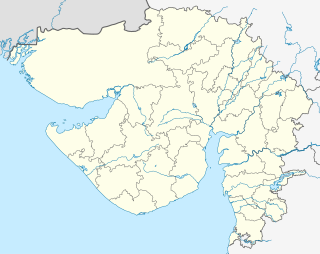
Khijadiya Bird Sanctuary is a bird sanctuary located in Jamnagar district of Gujarat, India. About 300 species of migratory birds have been recorded here.

Abdasa Taluka is a taluka in Kutch District, Gujarat, India. Its administrative centre is the town of Naliya. The taluka covers 2,398.26 square kilometres (926 sq mi).

Rollapadu Wildlife Sanctuary is a wildlife sanctuary in the Kurnool district of Andhra Pradesh, India. Known primarily as a habitat of the great Indian bustard, the species has suffered a drastic fall in its numbers in the sanctuary in recent years.













